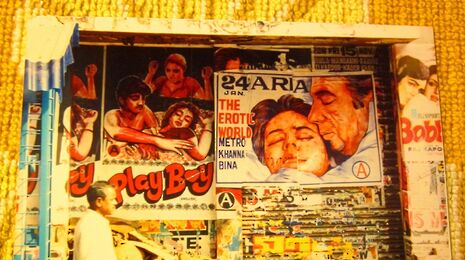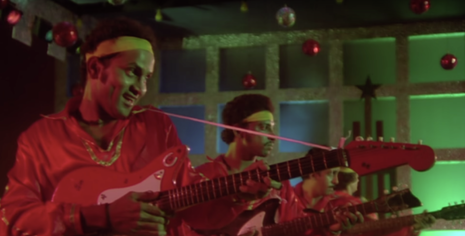Untold Stories: Bollywood and the Soviet Union
Esmee Wright uncovers the forgotten history behind the popularity of ‘the glitz and glamour’ of Bollywood cinema in the Soviet Union during the latter half of the 20th Century

Although it may not be widely appreciated nowadays, anyone studying Russian will probably tell you that one of the most interesting aspects of the culture is the development of cinema, especially during the Soviet era. Cinema of the avant-garde, socialist realism, and even the Soviet musical comedy all reveal fascinating aspects of a country whose culture is often overlooked in favour of its politics. Yet an area of Soviet cinema still less explored is the popularity of a ‘Bollywood’ cinema amongst Soviet audiences, which became one of the most popular genres in the Soviet era from its introduction in the 1950s.
Between 1954 and 1991, more than 200 Indian films were imported into the Soviet Union, in contrast to the 41 imported from the United States
Hollywood is more frequently recognised as the main influence on Soviet cinema of the 20th century. Boris Shumiatskii, one of the driving forces behind the development of Socialist realist cinema, went to Los Angeles on which he wrote a book insisting that Soviet cinema ought to use similar techniques. Cinema was being used as an opiate to the masses both in America and the Soviet Union to neutralise both the horrors of everyday life under Stalin, and the trauma of the Great Depression in ‘30s America.
Stalin was famously fond of Spaghetti Westerns, and it is in response to this that the ‘Eastern’ was created, replacing the Wild West with the East, an equally romantic setting of the Caucasian steppes, swapping ‘cowboys and Indians’ with a Caucasian stock cast of harems and bandits. The genre spawned such cult films as ‘Белое Солнце Пустыни’ (White Sun of the Desert), a film still ritually watched by Russian cosmonauts before launch.
However, it was Bollywood which made the greatest impression on Soviet cinema-goers. Between 1954 and 1991, more than 200 Indian films were imported into the Soviet Union, in contrast to the 41 imported from the United States. Disco Dancer (1982), a Bollywood film about a street performer gaining fame, fortune, and love by winning an International Disco Dancing Competition was the highest grossing film of the Soviet era, earning 60 million roubles at the box office. In second place for highest grossing foreign films was Awaara (1954), featuring the Bollywood heartthrob Raj Kapoor in a re-imagining of Romeo and Juliet, which was one of the first Bollywood films to be screened in the Soviet Union. It isn’t until fifth place that the USA enters the chart, with the 1961 Western The Magnificent Seven.
Of course the appeal of Bollywood cinema to a Soviet audience was very similar to that of American cinema. Arguably, the glitz and glamour is even more intense in Bollywood than in even the pictures of Marilyn Monroe and Steve McQueen. Bollywood’s colourful opulence is remarkable even now, and would have seemed an enticing escapist extravaganza to a viewer enduring the grey austerity of the Soviet Union. The values of Indian society also meshed fairly well with those of the USSR. There was always a clear separation between good and evil and a predilection for rags to riches narratives, the enduring optimism of which could exemplify the Socialist realist insistence on utopianism.

Allowing India’s rapidly expanding film industry to show their films in Soviet cinemas provided an appealing solution for Soviet authorities looking to provide their people with films that were not so influenced by Western culture, at least geographically. Of course, this influence persisted, Disco Dancer being one of the less subtle examples, but since Bollywood films were produced by a Soviet-friendly country, film censors were more inclined to let such Westernisms slide.
The presence of Bollywood in the Soviet Union points to more than just a desire for escapism – it also highlights an important political link between India and the USSR. India became independent from the British Empire in 1947, and, unsurprisingly, soon after that, the USSR began to make diplomatic gestures to India, with Indian Prime Minister Jawaharlal Nehru going to the Soviet Union in 1955, and Nikita Khrushchev, First Secretary of the Communist Party, returning the visit later the same year. It is a relationship which survived the fall of the Soviet Union, with Russia and India maintaining close links to this day, and often collaborating, or campaigning on each other’s behalf in international bodies such as the UN and the G20.
Sadly, this is not a relationship that has continued to be reflected in cinema. Towards the fall of the Soviet Union, Bollywood cinema and its values had already started to become less culturally relevant. Some citizens of post-Soviet states may still remember the popularity of Raj Kapoor and Nargis, something that was comparable to Beatlemania, but nowadays Bollywood’s primary draw in a post-Soviet context appears to be nostalgia.
Although Bollywood movies may still be shown on television on occasion, its main audience belong to an older generation, and in the rush of foreign information and entertainment flowing into Russia since the fall of the Soviet Union, Bollywood has been somewhat left behind.
 News / Cambridge bus strikes continue into new year16 January 2026
News / Cambridge bus strikes continue into new year16 January 2026 News / Uni members slam ‘totalitarian’ recommendation to stop vet course 15 January 2026
News / Uni members slam ‘totalitarian’ recommendation to stop vet course 15 January 2026 Science / Why smart students keep failing to quit smoking15 January 2026
Science / Why smart students keep failing to quit smoking15 January 2026 Interviews / The Cambridge Cupid: what’s the secret to a great date?14 January 2026
Interviews / The Cambridge Cupid: what’s the secret to a great date?14 January 2026 Comment / Will the town and gown divide ever truly be resolved?12 January 2026
Comment / Will the town and gown divide ever truly be resolved?12 January 2026









